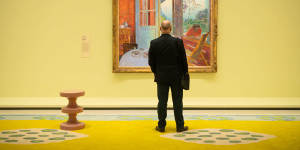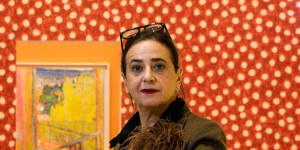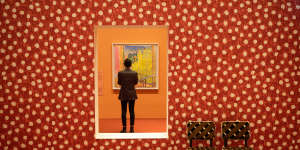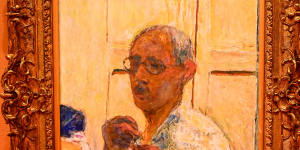His talent,particularly in his later period,was in a devotional way of seeing. In Bonnard’s world,some peaches piled onto a dish is the stuff of rapture:“They are so intense and soft,” he once said,“and some of them resemble the setting sun.”

Bonnard:Designed by India Mahdavi is currently on at the NGV.Justin McManus
It is this attention to the everyday sublime that suffuses NGV’s Melbourne Winter Masterpieces exhibitionBonnard:Designed by India Mahdavi, a jewel box of an exhibition that has been more than five years in the making. It brings together paintings,drawings,prints,photographs and decorative objects by Bonnard,shown alongside early cinema by the Lumière brothers and artworks by Bonnard’s contemporaries,and places them within eloquent scenography by Paris-based architect and designer India Mahdavi.
Like Bonnard,Mahdavi is known for her mastery of colour. In designing the exhibition,she set out to create “an impression of his world,through my own eyes.”
The exhibition is grand in scale,but designed in sympathy with Bonnard’s love of intimate,domestic spaces – instead of white plinths for visitors to sit on,there is a large,vibrantly yellow couch. A plush,oversized carpet unfurls across the floor. Paintings cohabit with walls that are tinted in macaron-hues of pistachio,rose and cerise,or awash with patterned wallpaper.
Mahdavi was inspired not only by Bonnard’s use of colour and light,but also his tendency towards distortion. “Bonnard painted through his memory,” she says. “The scenes he painted were through his own prism,his own mind – it wasn’t an exact reproduction of reality. He was trying to express the sensation of light,and moments,through his own vision.”

Exhibition designer India Mahdavi was inspired by Bonnard’s use of colour and light and his tendency towards distortion.Justin McManus
Faithful to this private,interior logic,Bonnard created composite scenes and occasionally surreal perspectives (,its legs elongated to comic proportion,is a lovely example of this) – and it is this sense that Mahdavi wanted to capture through her scenographic treatment.
The furniture,the wallpaper,the carpets,the windows that frame segments of the exhibition from one room to another are all meant to evoke “an abstraction of a home” – something that would feel as friendly and accessible as a domestic interior,but also plays with exaggeration,scale and lavish use of colour and pattern.
To the modern eye,wallpaper can feel garish. We are so inured to carefully neutral white and grey walls that anything else can feel like an assault to the senses. These days,it’s surprising enough to see wallpaper in a domestic interior – far less in the context of a gallery.

“They are wallpapers that belonged to Bonnard’s world.”Justin McManus
“It was a risk,” admits Mahdavi. “I was worried myself.” But,she explains,these are not just any wallpapers:“They are wallpapers that belonged to Bonnard’s world.”
To create them,Mahdavi sampled patterns from within Bonnard’s paintings and photographs as a basis for the designs,blew them up,abstracted them,and set them as backdrops that would complement,rather than distract from,the artist’s work.
“One of the things I like in Bonnard’s paintings,not only the colours,but the way he uses white. When you put white with a palette of saturated colours,it’s going to bring that effect of light,” she says. “Putting these paintings on coloured or wallpapered walls brings out all the vibrations that go on within the frame.”
Mahdavi is right – placed within this context,Bonnard’s work sings. Colours move across the surface of his paintings in constantly shifting interplay. His paintings – attentive to rays of light,ordinary objects,familiar landscapes – works in harmony with Mahdavi’s sympathetic design. The whole gallery radiates with the specificity of his vision.

Pierre Bonnard,‘Self Portrait’Justin McManus
“Colour acts,” Bonnard once said,summing up its power in a single word. In the depths of Melbourne winter,the exhibition comes as a much-needed corrective to the seasonal blues,a celebration of shimmering colour to brighten the greyest days.
For Mahdavi,the joy of working on this project was about being in creative exchange with Bonnard,as two artists separated by time but linked by a mutual obsession:with colour,with light,with the pure pleasure of the visual.
“It’s a conversation between me and Bonnard,” she says. “And through that conversation,you feel like you’re entering Bonnard’s world.”
is on at NGV until October 8.
The Booklist is a weekly newsletter for book lovers from books editor Jason Steger..
